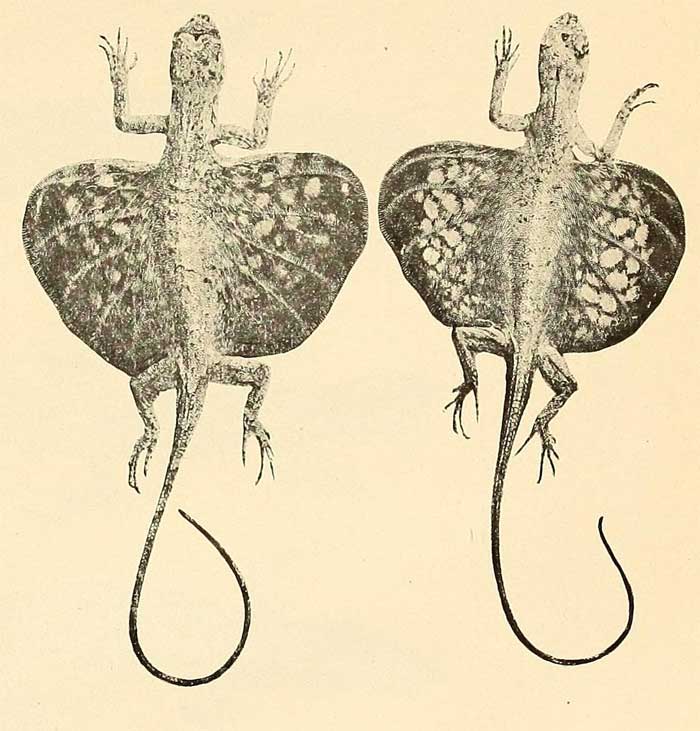
Superregnum: Eukaryota
Cladus: Unikonta
Cladus: Opisthokonta
Cladus: Holozoa
Regnum: Animalia
Subregnum: Eumetazoa
Cladus: Bilateria
Cladus: Nephrozoa
Superphylum: Deuterostomia
Phylum: Chordata
Subphylum: Vertebrata
Infraphylum: Gnathostomata
Megaclassis: Osteichthyes
Cladus: Sarcopterygii
Cladus: Rhipidistia
Cladus: Tetrapodomorpha
Cladus: Eotetrapodiformes
Cladus: Elpistostegalia
Superclassis: Tetrapoda
Cladus: Reptiliomorpha
Cladus: Amniota
Classis: Reptilia
Cladus: Eureptilia
Cladus: Romeriida
Subclassis: Diapsida
Cladus: Sauria
Infraclassis: Lepidosauromorpha
Superordo: Lepidosauria
Ordo: Squamata
Cladus: Unidentata Episquamata Toxicofera
Subordo: Iguania
Infraordo: Acrodonta
Familia: Agamidae
Subfamilia: Draconinae
Genus: Draco
Species: Draco guentheri
Name
Draco guentheri Boulenger, 1885: 257
Holotype: BMNH 79.4.16.4, ♀, collected by A. Everett.
Type locality: “Philippines”.
References
Primary references
Boulenger, G.A. 1885. Catalogue of the lizards in the British Museum (Natural History). Volume 1. Gekkonidae, Eublapheridae, Uroplatidae, Pygopodidae, Agamidae. Second edition. Trustees of the British Museum: London. xiii + 436 pp., 32 pls. BHL Reference page.
Links
Uetz, P. & Hallermann, J. 2022. Draco guentheri. The Reptile Database. Accessed on 15 February 2019.
Diesmos, A., Demegillo, A. & Gaulke, M. 2009. IUCN: Draco guentheri (Least Concern). The IUCN Red List of Threatened Species 2009: e.T169839A6680735. DOI: 10.2305/IUCN.UK.2009-2.RLTS.T169839A6680735.en
Vernacular names
English: Guenther's Flying Lizard
Draco guentheri, commonly known as Günther's flying lizard[2] is a species of agamid "flying dragon" endemic to the Philippines.
Geographic range
D. guentheri is found on the islands of Basilan, Bongao, Jolo, Mindanao, Sanga-Sanga, Siasi, and Simunul.
Etymology
The specific name, guentheri, is in honor of German-British zoologist Albert Gunther.[1][2]
Taxonomy
This species was originally described in 1885 by the Belgian-British zoologist George Albert Boulenger, who named it Draco guentheri.
This species is also notable for having been collected by the Philippine national hero Jose Rizal during his exile in Dapitan, Mindanao in 1893 and identified it as a new type of lizard in which he tentatively named, Draco dapitani. Rizal sent specimens to Europe, to the German zoologist Benno Wandolleck. In 1900 Wandolleck, thinking Rizal's specimens represented a new species, described it and named it Draco rizali, thereby creating a synonym. Rizal's specimens, subsequently, were destroyed during the bombing of Dresden in World War II.[3]
In 1936 Hennig considered this lizard to be part of what he called a subspecies, Draco volans reticulatus. In 1993 Gaulke raised it to full species status. And most recently, in 2000, McGuire and Alcala once again recognized Boulenger's original Draco guentheri as a valid species.
References
Uetz, Peter; Hallermann, Jakob; Hosek, Jiri. "Draco guentheri BOULENGER, 1885". The Reptile Database. Retrieved December 23, 2013.
Beolens, Bo; Watkins, Michael; Grayson, Michael (2011). The Eponym Dictionary of Reptiles. Baltimore: Johns Hopkins University Press. xiii + 296 pp. ISBN 978-1-4214-0135-5. (Draco guentheri, p. 110).
Fadul, José A., ed. (2007). Encyclopedia Rizaliana: Student Edition. Morrisville, South Carolina: Lulu Press. p. 32. ISBN 1430311428.
Further reading
Boulenger GA (1885). Catalogue of the Lizards in the British Museum (Natural History). Second Edition. Volume I. Geckonidæ, Eublepharidæ, Uroplatidæ, Pygopodidæ, Agamidæ. London: Trustees of the British Museum (Natural History). (Taylor and Francis, printers). xii + 436 pp. + Plates I- XXXII. (Draco guentheri, new species, pp. 257–258 + Plate XX, Figure 2).
McGuire JA, Alcala AC (2000). "A Taxonomic Revision of the Flying Lizards (Iguania: Agamidae: Draco) of the Philippine Islands, with a Description of a New Species". Herpetological Monographs 14: 81–138. (Draco guentheri, p. 100).
Retrieved from "http://en.wikipedia.org/"
All text is available under the terms of the GNU Free Documentation License

